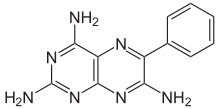Triamterine
 |
|
 |
|
| Clinical data | |
|---|---|
| Trade names | Dyrenium, Dyazide, Maxzide |
| AHFS/Drugs.com | Monograph |
| MedlinePlus | a682337 |
| Pregnancy category |
|
| Routes of administration |
oral |
| ATC code | |
| Legal status | |
| Legal status | |
| Pharmacokinetic data | |
| Bioavailability | 30-70% |
| Protein binding | 67% |
| Metabolism | conjugated to hydroxytriamterene |
| Biological half-life | 1-2 hours, active metabolite 3 hours |
| Excretion | renal <50%, 21% unchanged |
| Identifiers | |
|
|
| CAS Number | |
| PubChem CID | |
| IUPHAR/BPS | |
| DrugBank | |
| ChemSpider | |
| UNII | |
| KEGG | |
| ChEMBL | |
| ECHA InfoCard | 100.006.278 |
| Chemical and physical data | |
| Formula | C12H11N7 |
| Molar mass | 253.263 g/mol |
|
|
|
|
|
Triamterene (trade name Dyrenium) is a potassium-sparing diuretic used in combination with thiazide diuretics for the treatment of hypertension and edema. In combination with hydrochlorothiazide, it is marketed under the names Maxzide and Dyazide.
Triamterene directly blocks the epithelial sodium channel (ENaC) on the lumen side of the kidney collecting tubule. Other diuretics cause a decrease in the sodium concentration of the forming urine due to the entry of sodium into the cell via the ENaC, and the concomitant exit of potassium from the principal cell into the forming urine. Blocking ENaC prevents this from happening. Amiloride works in the same way. Sodium channel blockers directly inhibit the entry of sodium into the sodium channels.
Common side effects may include a depletion of sodium, folic acid and calcium, nausea, vomiting, diarrhea, headache, dizziness, fatigue, and dry mouth. Serious side effects may include heart palpitations, tingling/numbness, fever, chills, sore throat, rash, and back pain. Triamterene can also cause kidney stones through direct crystallization or by seeding calcium oxalate stones. Triamterene is best avoided in patients with chronic kidney disease due to the possibility of hyperkalemia. People using this drug should use salt substitute cautiously.
Triamterene may impart a blue fluorescent color to the urine.
Diabetes: Use with caution in patients with prediabetes or diabetes mellitus as there may be a change in glucose control.
...
Wikipedia
